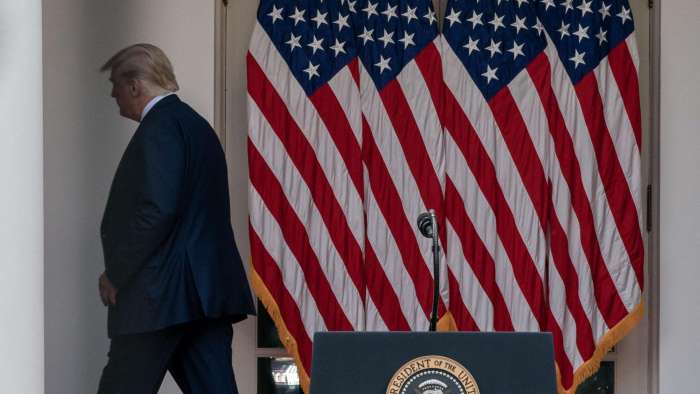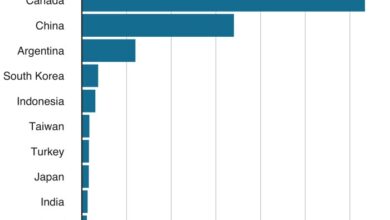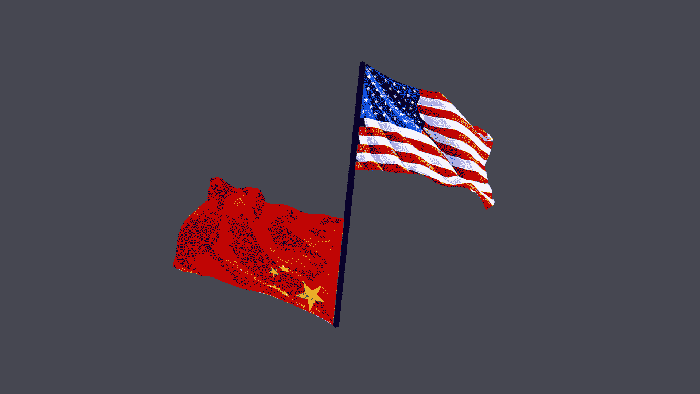
How Trump tariffs could affect your wallet? This exploration dives into the potential consequences of the Trump administration’s trade policies, examining how tariffs impacted consumer prices, business strategies, and the overall economy. We’ll look at the specifics of different tariffs, their effects on various industries, and the possible ripple effects on your daily spending.
From the initial implementation of tariffs to the resulting shifts in consumer behavior, we’ll unpack the intricate web of economic consequences. We’ll analyze how tariffs influenced prices, availability, and even job markets. This analysis will provide a clear picture of how these policies impacted your everyday life, including the goods you bought and the businesses you supported.
Introduction to Tariffs

Tariffs are taxes imposed on imported goods, effectively increasing their price for consumers. They are a common tool used by governments to protect domestic industries, influence trade relationships, and generate revenue. The economic impact of tariffs can be complex, often leading to higher prices for consumers, reduced choices, and potential trade wars.Tariffs can have various effects on different sectors of an economy.
They can shield domestic industries from foreign competition, but also potentially reduce the availability of cheaper goods and services. For example, tariffs on steel imports might support American steel producers but increase costs for car manufacturers who use steel. Understanding how tariffs work and their potential consequences is crucial for assessing their overall impact on the economy.
Definition of Tariffs
Tariffs are taxes levied on imported goods. They are a form of trade barrier that governments employ to influence international trade. Tariffs increase the cost of imported goods, making them less competitive with domestically produced goods. This can protect domestic industries from foreign competition and generate revenue for the government.
Trump tariffs are definitely something to watch out for, impacting your wallet in ways you might not expect. With Republicans now crafting a final Trump-backed budget bill, this could potentially influence how those tariffs are implemented or even adjusted. So, keep a close eye on things – it’s likely to have a ripple effect on your everyday spending.
Types of Tariffs
Different types of tariffs exist, each with varying characteristics.
- Ad valorem tariffs are based on a percentage of the value of the imported good. For example, a 10% ad valorem tariff on a $100 imported item would add $10 to the price.
- Specific tariffs are levied as a fixed amount per unit of the imported good. A $5 specific tariff on each imported chair, regardless of its price, would be an example.
Tariff Application Process
The process of applying tariffs to imported goods typically involves several steps:
- Identification of Imported Goods: Customs authorities identify imported goods through documentation and inspection. This involves verifying the type, quantity, and origin of the goods.
- Tariff Rate Determination: Based on the characteristics of the imported good, the applicable tariff rate is determined. This often involves referencing specific tariff schedules and regulations.
- Tariff Calculation: The tariff amount is calculated based on the chosen tariff type (ad valorem or specific). For ad valorem, the percentage is applied to the value of the good. For specific tariffs, the fixed amount per unit is multiplied by the number of units.
- Collection of Tariff Revenue: The calculated tariff amount is collected from the importer. This revenue goes to the government treasury.
Components of a Tariff
The following table illustrates the key components of a tariff:
| Tariff Rate | Imported Good | Unit | Value | Tariff Amount |
|---|---|---|---|---|
| 15% | Imported Steel | Ton | $1000 | $150 |
| $2 per unit | Imported Toys | Piece | $10 per toy | $2 per toy |
Trump’s Tariffs
The Trump administration’s trade policies, heavily reliant on tariffs, significantly impacted global markets and American consumers. These tariffs, intended to protect domestic industries and renegotiate trade agreements, generated considerable debate and economic repercussions. Understanding the specifics of these tariffs is crucial to grasping their effect on various sectors.
Key Characteristics of Trump’s Tariffs
Trump’s tariffs were characterized by their broad scope and substantial impact on various sectors. These tariffs were often imposed unilaterally, bypassing traditional international trade agreements. This approach aimed to exert leverage in trade negotiations but led to retaliatory measures from other countries. The tariffs were frequently applied to a wide range of goods, including steel, aluminum, and agricultural products, causing ripple effects throughout the supply chain.
Industries Most Affected by Tariffs
The implementation of tariffs under the Trump administration directly impacted several industries. The most affected industries included manufacturing, agriculture, and consumer goods. Manufacturing companies reliant on imported materials faced increased production costs, potentially impacting their competitiveness. Agricultural exports were also affected by tariffs imposed by other countries, reducing market access and revenues for American farmers. Consumer goods companies faced price increases for components and raw materials, which could be passed on to consumers in the form of higher prices.
Specific Goods Targeted by Tariffs
A variety of specific goods were targeted by tariffs. These included steel and aluminum products, solar panels, washing machines, and certain agricultural goods like soybeans. The selection of these goods reflected the administration’s focus on protecting domestic industries deemed vital to national security or economic competitiveness. Tariffs on these specific goods were intended to encourage domestic production and reduce reliance on imports.
Impact on Specific Sectors
The following table illustrates the different sectors affected by Trump’s tariffs and the corresponding tariff rates. Note that tariff rates could vary depending on the specific goods within a sector.
Trump tariffs, while seemingly distant, can actually impact your everyday spending. Increased import costs often trickle down to higher prices at the grocery store and for everyday goods. This ripple effect, unfortunately, isn’t limited to just your wallet. For example, recent cuts to AmeriCorps NCCC (National Civilian Community Corps) funding, detailed in this article americorps nccc doge funding cuts volunteers community service program trump , highlight how such policies can impact community service programs, ultimately affecting the economy and potentially leading to further price increases.
In the long run, these kinds of policies can have a considerable impact on your wallet, even if they don’t feel immediate.
| Sector | Tariff Rate | Affected Goods |
|---|---|---|
| Steel | 25% | Steel sheets, pipes, and other steel products |
| Aluminum | 10% or 25% | Aluminum sheets, foils, and other aluminum products |
| Solar Panels | 30% | Solar panels and components |
| Washing Machines | 50% | Washing machines and dryers |
| Agricultural Products (e.g., Soybeans) | Variable | Soybeans, pork, and other agricultural products |
Potential Impacts on Consumer Prices
Tariffs, essentially taxes on imported goods, are designed to protect domestic industries from foreign competition. However, the ultimate effect often ripples through the economy, impacting consumers in the form of higher prices. Understanding how these price increases manifest is crucial for navigating the economic consequences of tariffs.Imported goods, as their name suggests, are products sourced from other countries.
When tariffs are imposed, the cost of these imports rises. This increase isn’t simply added to the original price; it affects a complex web of supply chains, influencing retail prices in a cascading manner.
How Tariffs Increase the Cost of Imported Goods
Tariffs directly increase the price of imported goods by adding a tax to the import value. This tax, levied by the importing country, is passed on to the importer, who then must absorb the added cost or increase the selling price. Importantly, the tariff is not merely an additional fee; it alters the entire economic equation for the imported goods, impacting profitability and market dynamics.
Mechanisms of Tariff Impact on Retail Prices
The impact of tariffs on retail prices is a multifaceted process. The initial increase in import costs is often passed on to wholesalers, who then adjust their pricing strategies to reflect the added burden. This cost increase then filters down to retailers, who, in turn, must adjust their retail prices to maintain their profit margins. Ultimately, consumers bear the brunt of these cascading price increases.
In some cases, the retailer may absorb some of the cost increase, but the consumer ultimately bears some of the added cost, either directly or indirectly.
Potential Price Increases for Consumer Goods
Tariffs can affect a broad range of consumer goods, from electronics and apparel to food and beverages. The magnitude of the price increase depends on the specific tariff imposed, the volume of imports, and the responsiveness of the domestic market. In scenarios where the domestic industry is unable to readily supply the demanded goods, the price increase is often more significant.
Examples of Goods Likely to Experience Price Hikes Due to Tariffs
Several consumer goods are vulnerable to price hikes resulting from tariffs. For example, certain electronics, particularly those with components imported from countries subject to tariffs, may experience price increases. Likewise, imported apparel and footwear could see significant price hikes, as these items frequently utilize imported materials and manufacturing processes. Furthermore, certain food products reliant on imported ingredients or raw materials may also see price increases.
In some cases, substitute products from domestic suppliers may be less desirable or not available in sufficient quantities, further escalating the cost for consumers.
Trump’s tariffs might be pinching your wallet, impacting import costs and potentially raising prices on everyday goods. However, recent court decisions, like the judge’s stay on Trump’s humanitarian parole and temporary protected status for Cuba, Haiti, Nicaragua, and Venezuela here , could indirectly influence the economic landscape. Ultimately, the long-term effects of these policies on your wallet are still unfolding.
Tariff-Induced Price Comparison Table, How trump tariffs could affect your wallet
| Good | Price Before (USD) | Price After (USD) | Difference (USD) |
|---|---|---|---|
| Imported Smartphones | 800 | 900 | 100 |
| Imported Clothing | 50 | 60 | 10 |
| Imported Coffee Beans | 10 | 12 | 2 |
Note: This table provides illustrative examples. Actual price changes may vary depending on the specific tariff, market conditions, and other factors. The prices presented are estimates and should not be taken as definitive values.
Effects on Businesses and Supply Chains

Tariffs, particularly those imposed on imported goods, significantly impact businesses across various sectors. They alter the cost structure of production, forcing companies to re-evaluate their sourcing strategies and potentially relocate production facilities. The ripple effects extend throughout supply chains, potentially impacting consumer prices and overall economic activity.
Impact on Supply Chains and Sourcing Strategies
Tariffs introduce an additional cost to imported goods, effectively increasing the price of raw materials, components, and finished products. This makes imported inputs less competitive, prompting businesses to explore alternative sourcing options. Businesses must analyze the balance between the cost of the tariff and the potential cost savings of using domestic suppliers or alternative global sourcing locations. They also need to consider potential disruptions in supply chains due to increased transportation costs, logistics complexities, and potential retaliatory tariffs from other countries.
Potential for Business Relocation
The imposition of tariffs can make it less cost-effective for companies to manufacture goods in countries with high tariffs. This can incentivize businesses to relocate production facilities to countries with lower tariffs, seeking more favorable trade conditions. The decision to relocate is influenced by various factors, including the magnitude of the tariff, the availability of skilled labor in other countries, and the proximity to end markets.
For example, companies in the automotive industry might shift production to countries with lower tariffs on steel or other critical components.
Responses to Tariff Increases
Businesses employ various strategies to mitigate the negative impact of tariffs. These responses often involve shifting sourcing strategies, adjusting pricing models, and exploring alternative production methods. The choice of response is influenced by factors like the magnitude of the tariff, the company’s production capacity, and the nature of the industry.
- Shifting Suppliers: Businesses may switch from suppliers in countries subject to tariffs to those in countries with more favorable trade agreements. This requires careful evaluation of supplier reliability, quality, and delivery times. For example, a US-based electronics company may shift from sourcing components from China to Vietnam.
- Increasing Prices: Businesses might pass on the cost of tariffs to consumers by raising prices. This is often a last resort, as it can lead to reduced demand and affect market share. This is especially true if there are alternative sourcing options with lower tariffs.
- Seeking Alternative Production Methods: Businesses may explore alternative production methods to reduce reliance on imported components or materials. For example, companies in the textile industry may look to invest in domestic textile production to reduce tariff-related costs.
- Lobbying for Policy Changes: Businesses might engage in lobbying efforts to influence government policies and reduce tariff burdens. This could involve advocating for trade agreements or challenging the validity of tariffs through legal channels.
Examples of Sector-Specific Impacts
The impact of tariffs varies across sectors. For example, the steel industry faces significant challenges when tariffs increase on imported steel, as this directly affects their cost structure. Similarly, the automotive industry is susceptible to tariff increases on imported parts, impacting the cost and availability of vehicles.
| Business Response | Sector | Reasoning |
|---|---|---|
| Shifting suppliers | Electronics | To reduce reliance on suppliers in countries with high tariffs |
| Increasing prices | Automotive | To account for the additional cost of imported components |
| Seeking alternative production methods | Textiles | To minimize reliance on imported materials subject to tariffs |
| Lobbying for policy changes | Pharmaceuticals | To influence government policies on imported drugs and reduce tariff burdens |
Potential for Job Losses or Gains
Tariffs, while intended to protect domestic industries, can have complex and often unpredictable effects on employment. The impact is not uniform across sectors, and the potential for job losses in some areas may be offset by gains in others. Understanding these potential shifts is crucial for assessing the overall economic consequences of tariff policies.
Job Losses in Import-Dependent Sectors
Tariffs increase the price of imported goods, making them less competitive with domestically produced alternatives. This can lead to a decrease in demand for imported products, impacting industries that rely heavily on imports for components, raw materials, or finished goods. For example, a tariff on steel imports could raise costs for auto manufacturers, potentially reducing their output and leading to job losses in the automotive sector.
The reduction in demand for imported goods can ripple through the supply chain, affecting related industries like transportation and logistics. In extreme cases, entire industries reliant on specific imports could face significant challenges, leading to widespread job losses.
Job Creation in Domestic Industries
Conversely, tariffs can provide a competitive advantage to domestic producers. By increasing the price of imported goods, tariffs effectively reduce competition from foreign producers, potentially boosting domestic production and employment. This is often seen in industries that produce goods that are now subject to lower competition. For instance, a tariff on foreign-made textiles could incentivize consumers to purchase domestically produced textiles, leading to increased production and potentially more jobs in the textile industry.
The increased demand for domestically produced goods often leads to increased production and the need for more workers to meet this demand.
Job Displacement in Import-Dependent Sectors: A Detailed Look
The impact of tariffs on import-dependent sectors is not always straightforward. Companies that rely on imported components or materials might face increased costs, potentially forcing them to reduce production, lay off workers, or even relocate to areas with lower input costs. Import-dependent industries often face a choice between absorbing the increased costs, passing them on to consumers, or finding alternative sources, which can lead to various consequences.
For example, a company that manufactures electronics might need to cut costs to offset the higher price of imported components, leading to potential job cuts. The loss of jobs in import-dependent sectors can often have a cascading effect on related industries, impacting suppliers and retailers.
Job Creation in Industries Producing Goods Now Subject to Lower Competition
Tariffs can create new opportunities for domestic industries by reducing the competition they face from foreign producers. This can lead to increased output and a need for more workers to meet the higher demand. A tariff on imported goods can shift demand towards domestic products, stimulating domestic production and creating new job opportunities. This effect can be particularly pronounced in industries where domestic production capacity is currently underutilized or where the industry is in a period of growth.
Comparison of Potential Job Losses and Gains
| Sector | Potential Job Losses | Potential Job Gains |
|---|---|---|
| Automotive | Reduced demand for imported steel, potentially leading to layoffs in steel-dependent auto parts manufacturers. | Increased demand for domestically produced cars and parts, leading to job growth in auto assembly plants and related industries. |
| Textiles | Higher costs for imported fabrics and materials, potentially impacting clothing manufacturers and related jobs. | Increased demand for domestically produced textiles, leading to job creation in textile mills and related industries. |
| Electronics | Higher costs for imported components, impacting electronics manufacturing and potentially leading to layoffs. | Increased demand for domestically produced electronic components and appliances, leading to job growth in component manufacturing and related industries. |
| Agriculture | Increased costs for imported inputs, potentially impacting farmers. | Increased demand for domestically produced agricultural goods, potentially leading to job creation in farms and related industries. |
Consumer Responses to Tariff Increases
Tariff increases, often implemented to protect domestic industries, invariably lead to higher prices for imported goods. This price escalation directly impacts consumers, prompting various reactions and adjustments in their purchasing behaviors. Understanding these responses is crucial for assessing the overall economic impact of tariffs.
Potential Consumer Reactions to Price Increases
Consumers respond to price increases for goods in a variety of ways, ranging from minor adjustments to significant shifts in purchasing patterns. Price sensitivity, income levels, and the availability of substitute goods all play a role in determining the consumer response. Consumers may delay purchases, seek out cheaper alternatives, or reduce their consumption of the affected goods. These actions, when aggregated across a large consumer base, can have a substantial impact on market demand and, consequently, on the profitability of businesses involved in the import and sale of affected goods.
How Consumers Might Adjust Purchasing Habits
Facing higher prices, consumers frequently adjust their purchasing habits. One common response is to delay purchases, waiting for prices to stabilize or for sales to occur. Another response is to reduce consumption, buying less of the affected goods. For example, if the price of imported electronics rises significantly, consumers might postpone upgrading their devices or opt for lower-priced models.
Consumers might also shift their purchasing to different brands or products, even within the same category.
Examples of Consumer Substitutions
Consumers often seek out substitutes when faced with higher prices. If the price of imported coffee increases due to tariffs, consumers might switch to locally grown coffee beans or other beverage options. If the price of imported cars rises, consumers might consider purchasing domestically produced cars or vehicles from different manufacturers. This substitution can be a complex process, influenced by factors such as brand loyalty, product features, and perceived quality.
Table Outlining Consumer Responses to Rising Prices
| Consumer Response | Reasoning | Affected Goods |
|---|---|---|
| Delay Purchases | Waiting for prices to stabilize or for sales | Imported electronics, appliances, clothing |
| Reduce Consumption | Cutting back on purchases of affected goods | Imported food items, luxury goods |
| Substitute Products | Finding alternatives due to price increases | Imported coffee, cars, consumer electronics |
| Increase Purchasing of Cheaper Alternatives | Seeking lower-priced alternatives to maintain consumption levels | Generic brands, domestically produced items |
| Shift Consumption to Different Categories | Replacing purchases with goods in different product categories | Imported clothing, furniture |
Illustrative Case Studies: How Trump Tariffs Could Affect Your Wallet
Trump’s tariffs, implemented across various sectors, had a tangible impact on consumers and businesses. Understanding these impacts requires examining specific cases. The following case studies offer a glimpse into the real-world consequences of these policies.
Steel Tariffs
The steel industry was a major target of Trump’s tariffs. These tariffs aimed to protect domestic steel producers from foreign competition. The goal was to boost American steel production and jobs. However, the impact extended beyond the steel mills.
| Case Study | Goods/Industry | Impact on Price/Availability | Affected Parties |
|---|---|---|---|
| American Auto Manufacturers | Steel | Increased steel prices led to higher costs for car manufacturers, impacting car prices. Availability of steel could have been affected depending on the source and volume of imported steel. | American auto manufacturers, consumers of steel, and ultimately, consumers of automobiles. |
| Construction | Steel | Higher steel prices translated into more expensive construction projects. This influenced project timelines and profitability for contractors. Supply chain disruptions were possible if American steel was not enough to meet demand. | Construction companies, homeowners, and contractors. |
Washing Machines
Tariffs on imported washing machines were implemented with the intent of supporting American manufacturers. The anticipated effect was to increase the competitiveness of American brands and bolster domestic employment.
| Case Study | Goods/Industry | Impact on Price/Availability | Affected Parties |
|---|---|---|---|
| Consumers | Washing Machines | Increased prices for washing machines. The tariffs increased the cost of importing machines, directly impacting the price consumers paid. Consumers may have seen a decrease in the variety of washing machine options. | Consumers purchasing washing machines. |
| American Manufacturers | Washing Machines | Initially, some American manufacturers experienced a boost in sales. However, long-term effects are uncertain and may vary based on consumer response to price increases and availability. | American washing machine manufacturers. |
Solar Panels
The solar panel industry faced tariffs, reflecting the administration’s aim to support American manufacturers. This policy had far-reaching consequences for the sector and consumers.
| Case Study | Goods/Industry | Impact on Price/Availability | Affected Parties |
|---|---|---|---|
| Consumers | Solar Panels | Increased costs for solar panels. This made solar energy less affordable for homeowners and businesses, potentially hindering the adoption of renewable energy. A reduction in choice of models and brands was a possibility. | Homeowners and businesses considering installing solar panels. |
| American Manufacturers | Solar Panels | The tariffs aimed to bolster American solar panel manufacturers. However, the effects on their competitiveness in the long term could vary, depending on how the supply chain was affected and how consumers responded to the price increase. | American solar panel manufacturers. |
Agricultural Products
Tariffs on agricultural products were implemented to protect domestic farmers. The impact was multifaceted and affected consumers and producers differently.
| Case Study | Goods/Industry | Impact on Price/Availability | Affected Parties |
|---|---|---|---|
| Consumers | Agricultural Products (e.g., soybeans) | Higher prices for imported agricultural products like soybeans, potentially leading to increased food prices for consumers. | Consumers purchasing food products containing agricultural products. |
| American Farmers | Agricultural Products | Some American farmers benefited from reduced foreign competition, but the overall effect was complex and dependent on various factors like domestic demand and global market fluctuations. | American farmers. |
Long-Term Economic Implications
Tariffs, while seemingly a short-term measure to protect domestic industries, can have profound and lasting effects on the global economy. Their impact extends far beyond the immediate price adjustments, influencing everything from international trade relationships to long-term economic growth. Understanding these long-term implications is crucial for policymakers and businesses alike.The long-term effects of tariffs are complex and often unpredictable.
While proponents may argue for short-term gains in specific sectors, the cumulative impact across the economy and globally can be significantly negative, potentially hindering overall growth and prosperity. This is especially true when considering the interconnected nature of global supply chains and the potential for retaliatory measures.
Long-Term Impacts on Global Trade
Tariffs create a complex web of economic consequences that reverberate through international trade relationships. They can lead to reduced trade volumes, as businesses seek to avoid the added costs and complexities. This reduction in trade can harm economic growth by limiting access to diverse markets and specialized goods. The ripple effects extend to related industries and sectors, causing cascading impacts.
Retaliatory Measures and Trade Wars
Retaliatory tariffs, a common response to initial tariff implementations, are a major concern. These measures can escalate into full-blown trade wars, characterized by escalating tariffs and reduced trade flows between countries. The 2018-2019 trade war between the United States and China is a prime example of the detrimental effects of such conflicts. The uncertainty and instability created by trade wars significantly impact investor confidence and can hinder economic development in the affected countries.
Weakening of Global Supply Chains
Tariffs disrupt established global supply chains, forcing businesses to adapt and potentially relocate production facilities. This disruption can lead to higher production costs, reduced efficiency, and a decline in overall economic output. The long-term impact on supply chain resilience and reliability is substantial. Companies may seek alternative suppliers, leading to a shift in global trade patterns.
Impact on Consumer Prices and Choice
Tariffs can result in increased consumer prices as imported goods become more expensive. This increase can disproportionately affect consumers, particularly those with lower incomes. Reduced choices in imported goods and services are also common, impacting consumer welfare and potentially lowering overall standards of living.
Reduced Foreign Investment
Uncertainty created by tariffs can deter foreign investment in affected countries. Businesses may be hesitant to invest in economies where trade relations are unstable or where tariffs could create future disruptions. This lack of investment can hinder economic growth and job creation in the long term.
Erosion of Trust and Cooperation
Tariffs can erode trust and cooperation between nations, making future trade agreements more challenging to negotiate and implement. This can lead to a decline in global economic cooperation, which can negatively impact international relations and economic growth. Historical examples of trade disputes demonstrate how long-term damage can result from escalating trade conflicts.
Final Review
In conclusion, the Trump tariffs presented a complex interplay of economic forces, impacting consumers, businesses, and the global economy. Understanding these intricate interactions helps us better comprehend the potential ramifications of trade policies. The effects on your wallet, whether direct or indirect, were significant, and this analysis provides insights into how such policies can shape the market and your financial decisions.





